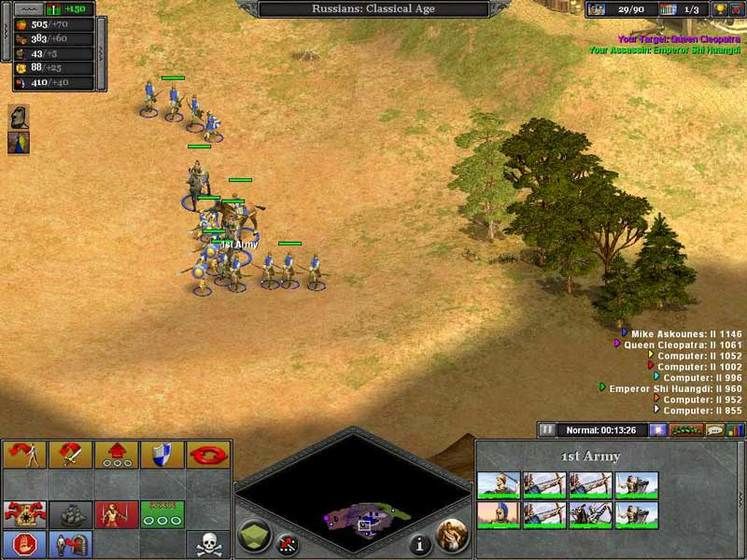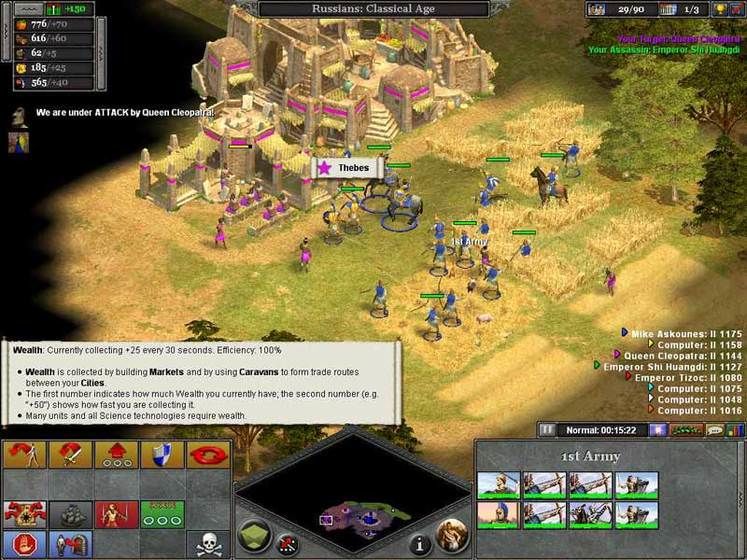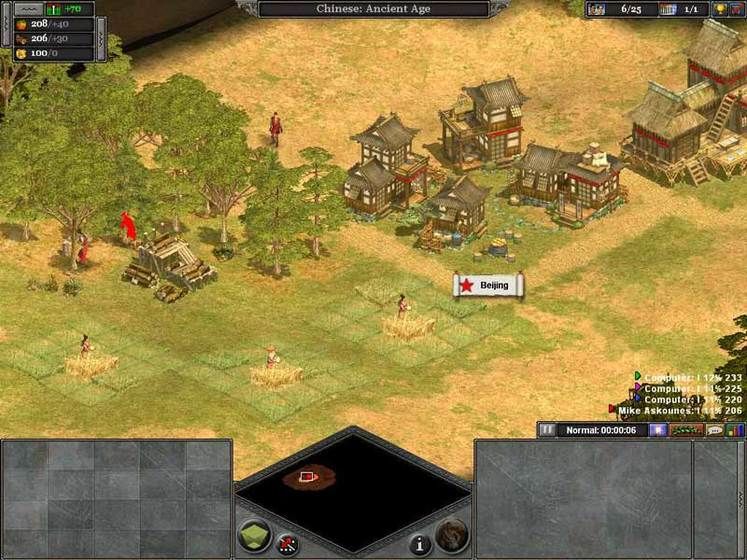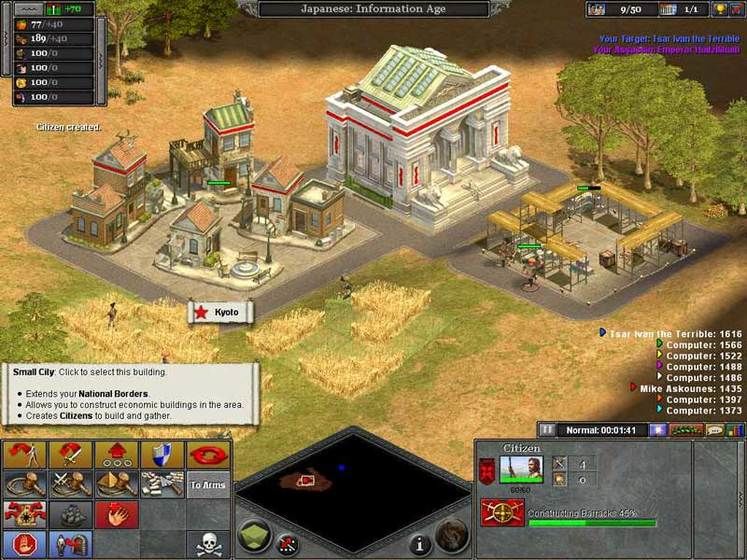In a nutshell, imagine combining Civilization with Age of Empires, as well as throwing in a smattering of Risk or Total War and you get a game that looks, sounds and IS very impressive.
The intro graphics set the scene superbly - much akin to Age of Mythology - animation that is damn near to live film quality. This takes you nicely to the menu screen, which is where the fun really starts.
There is a multi stage Tutorial, allowing gamers of differing experience to jump in and catch up with any new innovations without having to ‘start from scratch’. Broadly speaking, the controls are of the standard variety meaning if you have played AoE or just about any other strategy game, you will soon have your units running around following your commands. Differences soon start appearing though - expansion is based upon the ‘city’ concept rather than the time honored ‘town hall’. Each City can have a certain amount of buildings (5 farms for example) and, as more buildings are added, so the city size and strength grows with it. Civic buildings (i.e. not military) however can only be built within the city limits, so, to expand and conquer, you need to build or capture new cities to expand your own borders. Resources gathered ideally need to be within the city limits (shown as a red circle), although they can be gathered from outside the limits, but will not receive any development bonuses garnered from some of the specialized civic buildings (i.e. a granary). Resources themselves are ‘unlimited’ - assigning your citizens (not peasants) to get some lumber will not result in the eradication of the forest - you can assume a full programme of harvesting and replanting takes place ‘invisibly’. Once you have built your lumber mill, only a certain amount of citizens can work there, any spare will automatically find themselves something else to do within the city limits - if you have some ‘idle’ citizens, you can just send them to other cities to make up any shortfall.
The first city built is always your capital - it is automatically named Civ style, dependant on which of 18 differing nations you have chosen, although you have the option to rename it and any other cities to those of your choice. Your capital is vital, if it gets conquered, your game is over (more about that later). As you build more cities, you set up trade routes between them to garner yourself some gold and very soon roads will spring up as the caravans ply their trade. Various buildings within each city also directly affect the size of your territory through research and advancements. Temples increase your influence (enlarge your borders), increase your City’s hit points and damage potential, as well as maintain tax levels and thus your gold income.
There are 8 ‘Ages’ within the game enabling individual enhancements to your growing civilization, and these are reached through the research process. Your Library is the key to all research, clicking on it (or using the “L” hotkey) brings up your research table unobtrusively in the bottom left of your screen. Here you can choose which of the 4 research paths (Military, Commercial, Civic or Science) is needed to bring about any changes you particularly desire. Some time should be spent getting to know all about Research because you do not have to follow a predefined path - it is quite possible, and often economically imperative, that you concentrate on specific areas and just catch up on others as and when you can afford it. As your research develops, so you advance through the ages, hopefully gaining technological advantages over you competitors. Each advance costs though, so is inextricably linked to your resource production. This means it is vital to get a good economy going so as to be able to afford the changes you want to bring in.
There are 6 Resources; Gold, Food, Wood, Metal, Oil and Knowledge. The 1st 5 are acquired through the ‘normal routes (although Oil is not available until the Industrial age). Knowledge however, requires the construction of Universities within your cities. Each University can hold up to 7 scholars who beaver away at their books to produce the Knowledge so vital to successful development. In addition, each University (like other major buildings) also has its own research paths that enable the scholars to improve their studies and increase the flow of Knowledge. While economic micromanagement is kept, to a large extent, ‘in the background’, Research is manually controlled and needs to be addressed regularly, both for the ‘main’ research as well as individual types. This is however, not an onerous task as the interface makes it quick and simple. You don’t need to look at a huge, complicated research tree to make your decisions, a swift tap of the “L” key and a quick glance around is all that is normally needed to make your decisions. The status of your resource collection is shown via an expandable table top left of the screen. Here you can see how many miners/ farmers etc you should have and how many you actually have as well as whether you have reached your economic ‘cap’ (flashing yellow - research Commercial quick).
Also available for building are the good old Civilization style ‘Wonders’ that can bestow advantages to your chosen race. As an example, once built, the Terracotta Army generates an infantry squad on a regular basis, allowing you a pool of ready, military might who can assemble anywhere you want them to ready to further decimate your opponent.
Your military units all develop over time, from a basic slingshot unit through to “Special Services” types, with the addition of ‘extras’, like the Flamethrower, as your civilization develops. A nice enhancement here is that 1 infantry type unit is made up of 3 individuals, and, as they deploy, take full account of standard military tactics like flanking. Throwing a large force at an enemy results in some subtle strategical maneuvers rather than the standard head to head melee so typical of most strategy games. Barracks, Stables, Siege Factories and later, Airfields all need to be built as strategically as possible to ensure a flow of troops for defense and, of course, the all important offence. Battles tend to concentrate round cities and often follow the format of: attack a city - repel the inevitable counter attack, continue the attack until the city is about to fall, occupy the city with infantry, and, after 2 minutes, claim the city as your own and expand your borders accordingly. During the 2-minute “assimilation” phase, you need to ensure military superiority within the city limits, if a larger enemy force enters, the city will revert back to its former owner. It is here that the importance of the Capital city comes into play, Once the enemy’s capital is taken, it is ‘game over’ for him (or you if you are unfortunate enough to be on the receiving end). If you can locate the capital and take it, any remaining ‘enemy’ cities automatically come under your control and your borders expand dramatically. Good use can be made of air units to wear down city defenses (even to the extent of using cruise and/or nuclear missiles) so as to minimize losses and keep the all-important superiority. In addition, building a fortress allows you to utilize generals and spies, the former being able to make all the difference in any given situation as he directly affects the morale and capabilities of any army ‘under his control’, whilst the Spy can be used to subvert enemy units and acquire valuable knowledge of any enemy buildings and/or units.
So there you have it, a fantastic game that fully enhances any other RTS game out there and, to a degree, makes them obsolete. But, I hear you cry, what about the Risk/Total war elements - I saved the best for last.
Imagine all I described above as ‘just a skirmish’ game and you can see just how involved and hugely playable it is. Now, throw in a world map, choose one of 18 civilizations and go for world domination The initial ‘board’ setup will be very familiar to Risk aficionados. Once you have chosen which civilization you wish to rule, your initial country is highlighted with an army all ready to go. Clicking the army shows you all the movement options available and any territories that you can attempt to conquer. A click on the chosen territory will bring up a few details, although you can see at a glance, via the icons, exactly what profits, apart from territorial gain, you can achieve by conquest. Some countries yield extra armies, others special resources or Wonders, or any combination of them, simply dragging your army to its destination will initiate the attack. Topography also plays a part in CTW - attacking England from France means you have to cross the English Channel with your armies so at the outset you get a good idea of what kind of battle you are likely to encounter. When attacking, if you (or any allies you may have) already hold adjacent territories to the target, then any armies in those territories will appear in the battle as reinforcements. Indeed, if your attacking force dramatically outnumbers the defense, you achieve an ‘overrun victory’, meaning that the enemy surrendered and you immediately gain the territory and bonuses. This does not count as your move allowing you to chose another territory to conquer.
As your conquest of the world develops, so your Tribute level increases with each individual conquest, allowing you to spend money building up territories, bribing other countries or buying the bonus cards that come into play within CTW. These can be anything from initial extra resources, to cards which can reduce the enemies defense and or military effectiveness. The use of these cards is dependant on the type of battle chosen by the AI initially - you only get to play them if a full scale scenario is chosen (ie build cities, expand and conquer), rather than the quick, 15 minute timed, ‘field battles’. Your citizens within CTW cannot build wonders - these can be captured by attacking the original ‘holding’ country or by playing the most desirable ‘Wonders’ card. Once gained however, the benefits from the Wonders are available to you in every campaign.
The choice of your civilization directly affects your style of play within CTW. Some nations are defensive, some neutral and others downright aggressive so choosing the Egyptians for example, means that due to their extra farm allowance, you will not have so many economic nightmares in the early stages of the game. However, as their military is not overly impressive, you will need to depend heavily on outnumbering the opposition in the later stages of the game. You will eventually chose you favorite nation (I like the Germans - downright nasty and extremely powerful in the latter stages), but with 18 nations to chose from and each one playing subtly differently from all the others, you can see there will be many hours of entertainment from CTW alone.
On top of all that described above, RoN also supports full online multiplayer capability, hosted by Gamespy (as well as direct ISP links to individual PC’s etc ideal for LAN fests & the like). Just connecting to Gamespy shows all the rooms & games available, opens up the chat panel & allows you to choose whatever type of game you fancy playing. Patches & updates are detected and downloaded automatically when you start the game. There does appear however, to be a problem within multiplay inasmuch as games crash frequently which is causing a lot of frustration among the online gamers. In addition, it also appears that some people cannot even play online due to the game being unable to detect the online connection. Because of this, the overall score has been marked down accordingly.
RISE OF NATIONS VERDICT
When you take into account the versatility, longevity and downright playability of this game, you can easily see that this is going to be THE RTS game of the year and will be the game that sets the new benchmark for all others to follow.









